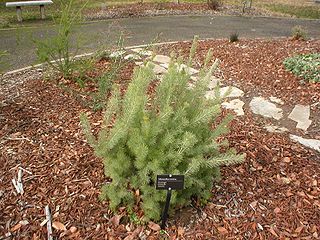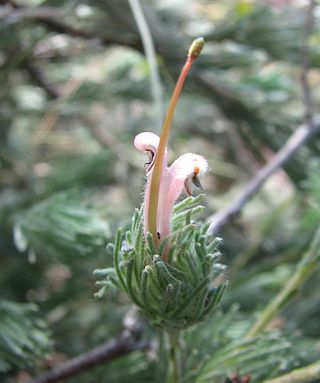This is a list of Adenanthos species, subspecies and named hybrids. Taxa are listed in alphabetical order, and summary information is provided. For the most recent taxonomic arrangement, see Nelson's taxonomic arrangement of Adenanthos.
| Name | Description | Taxonomy | Distribution and habitat | Conservation status [1] | Image | |||||
|---|---|---|---|---|---|---|---|---|---|---|
| Habit [2] | Leaf type [3] | Flower colour | Published | Section | Range | Soil | Vegetation | |||
| A. acanthophyllus (Prickly Woollybush) | Tall shrub, lignotuberous | Holly-like | Dark red to pale pink-red | A.S.George, 1974 | A. sect. Adenanthos | Shark Bay | Sand of marine origin | Scrub or heath | ||
| A. apiculatus | Prostrate subshrub, non-lignotuberous | Entire or lobed | Cream | R.Br., 1810 | A. sect. Adenanthos | Stirling Range to King George Sound and Bremer Bay | Lateritic soils, sand | Scrub or heath | ||
| A. argyreus (Little Woollybush) | Small shrub, non-lignotuberous | Laciniate | Bright red-pink | Diels, 1905 | A. sect. Adenanthos | Lake King to Wyallkatchem to Southern Cross | Lateritic sand | Scrub or heath | ||
| A. barbiger (Hairy Glandflower) | Small shrub, lignotuberous | Entire or lobed | Scarlet | Lindl., 1839 | A. sect. Eurylaema | Toodyay to Manjimup to Augusta | Lateritic gravel | Open forest | ||
| A. cacomorphus | Medium shrub, lignotuberous | Laciniate | Bright pink | E.C.Nelson, 1978 | A. sect. Adenanthos | Fitzgerald River | Lateritic sand | Scrub or heath | Priority 2 (WA) | |
| A. cuneatus (Coastal Jugflower) | Medium shrub, occasionally a prostrate subshrub, lignotuberous | Laciniate | Crimson | Labill., 1805 | A. sect. Adenanthos | Walpole to Twilight Cove | Sand | Scrub or heath |  | |
| A. × cunninghamii (Albany Woollybush) | Medium shrub, non-lignotuberous | Laciniate | Dull crimson | Meisn., 1845 | A. sect. Adenanthos | King George Sound | Sand of marine origin | Scrub or heath | Priority 4 (WA) | |
| A. cygnorum (Common Woollybush) | Tall shrub or prostrate subshrub, non-lignotuberous | Laciniate | Light pink, cream, or green | Diels, 1905 | A. sect. Adenanthos | Kalbarra to Arthur River | Lateritic soils, sand | |||
| A. cygnorum subsp. chamaephyton | Prostrate subshrub, non-lignotuberous | Laciniate | Light pink, cream, or green | E.C.Nelson, 1978 | A. sect. Adenanthos | Mundaring and Chidlow | Lateritic gravel | Open forest | Priority 4 (WA) | |
| A. cygnorum subsp. cygnorum (Common Woollybush) | Tall shrub, occasionally a tree, non-lignotuberous | Laciniate | Light pink, cream, or green | A. sect. Adenanthos | Kalbarra to Arthur River | Lateritic soils, sand | Open forest, scrub or heath |  | ||
| A. detmoldii (Scott River Jugflower) | Tall shrub, non-lignotuberous | Entire or lobed | Yellow and orange/brown | F.Muell., 1874 | A. sect. Eurylaema | Scott River to Whicher Range | Peat and waterlogged soils | Scrub or heath | Priority 4 (WA) |  |
| A. dobagii (Fitzgerald Woollybush) | Small shrub, non-lignotuberous | Laciniate | Cream or pale pink | E.C.Nelson, 1978 | A. sect. Adenanthos | Fitzgerald River | Skeletal soils | Scrub or heath | Endangered (EPBC Act) Rare (WA) | |
| A. dobsonii | Small shrub, lignotuberous | Entire or lobed | Red and/or cream | F.Muell., 1868 | A. sect. Adenanthos | Cape Arid to Israelite Bay | Sand | Scrub or heath | ||
| A. drummondii | Small shrub, lignotuberous [4] | Laciniate | Scarlet apex, yellow base | Meisn., 1845 | A. sect. Adenanthos | Bullsbrook to Wongan Hills to Three Springs | Lateritic soils | Scrub or heath | ||
| A. ellipticus (Oval-leaf Adenanthos) | Medium shrub, non-lignotuberous | Entire or lobed | Orange-red and cream | A.S.George, 1974 | A. sect. Adenanthos | Mount Barren Ranges | Skeletal soils | Scrub or heath | Vulnerable (EPBC Act) Rare (WA) | |
| A. eyrei (Toolinna Adenanthos) | Small shrub, non-lignotuberous | Laciniate | Dark crimson | E.C.Nelson, 1978 | A. sect. Adenanthos | Toolinna | Sand of marine origin | Scrub or heath | Endangered (EPBC Act) Rare (WA) | |
| A. filifolius | Medium shrub, non-lignotuberous | Laciniate | Cream and black | Benth., 1870 | A. sect. Adenanthos | Stirling Range to King George Sound and Bremer Bay | Skeletal soils | Scrub or heath | Priority 3 (WA) | |
| A. flavidiflorus | Small shrub, lignotuberous | Laciniate | Bright red-pink | F.Muell., 1859 | A. sect. Adenanthos | Bremer Bay to Hyden | Lateritic sand | Scrub or heath | ||
| A. forrestii | Medium shrub, lignotuberous | Laciniate | Pale red and cream, or cream | F.Muell., 1882 | A. sect. Adenanthos | Twilight Cove, Toolinna and Israelite Plain | Sand of marine origin | Scrub or heath | ||
| A. glabrescens | Small shrub, with or without lignotuber | Entire or lobed | Pink-scarlet and cream | E.C.Nelson, 1978 | A. sect. Adenanthos | Lake King to Fitzgerald River to Ravensthorpe | Skeletal soils and lateritic sand | Scrub or heath | ||
| A. glabrescens subsp. exasperatus | Small shrub, non-lignotuberous | Entire or lobed | Pink-scarlet and cream | E.C.Nelson, 1978 | A. sect. Adenanthos | Lake King to Halls Track | Skeletal soils | Scrub or heath | ||
| A. glabrescens subsp. glabrescens | Small shrub, lignotuberous | Entire or lobed | Pink-scarlet and cream | A. sect. Adenanthos | Fitzgerald River to Ravensthorpe | Lateritic sand | Scrub or heath | |||
| A. gracilipes | Small shrub, lignotuberous | Laciniate | Cream and red-pink | A.S.George, 1974 | A. sect. Adenanthos | Johnson Lakes and Frank Hann National Park | Lateritic sand | Scrub or heath | Priority 3 (WA) | |
| A. ileticos (Club-leaf Adenanthos) | Medium shrub, lignotuberous | Laciniate | Pale pink-red | E.C.Nelson, 1978 | A. sect. Adenanthos | Esperance to Norseman | Lateritic sand | Open forest, woodland | Priority 4 (WA) | |
| A. labillardierei | Medium shrub, non-lignotuberous | Laciniate | Cream and claret | E.C.Nelson, 1978 | A. sect. Adenanthos | Barren Ranges | Skeletal soils | Scrub or heath | Priority 4 (WA) | |
| A. linearis | Small shrub, non-lignotuberous | Entire or lobed | Cream with pink apex | Meisn., 1856 | A. sect. Adenanthos | Stirling Range to King George Sound and Bremer Bay | Skeletal soils | Scrub or heath | Priority 2 (WA) | |
| A. macropodianus (Kangaroo Island Gland Flower) | Medium shrub, non-lignotuberous | Laciniate | Red-pink | E.C.Nelson, 1978 | A. sect. Adenanthos | Kangaroo Island | Lateritic soils, sand | Open forest, scrub or heath |  | |
| A. meisneri (Prostrate Woollybush) | Medium shrub, lignotuberous | Laciniate | Red-purple or purple | Meisn., 1845 | A. sect. Adenanthos | Swan River to Point D'Entrecasteaux | Sand | Open forest, scrub or heath |  | |
| A. obovatus (Basket Flower) | Small shrub, lignotuberous | Entire or lobed | Scarlet | Labill., 1805 | A. sect. Eurylaema | Gingin to Augusta to Green Range, also Narrogin | Skeletal soils, lateritic sand, peaty sand and waterlogged soils | Open forest, scrub or heath |  | |
| A. oreophilus (Woollybush) | Medium shrub, non-lignotuberous | Laciniate | Scarlet | E.C.Nelson, 1978 | A. sect. Adenanthos | Fitzgerald River area | Lateritic gravel | Scrub or heath | ||
| A. × pamela | Medium shrub, lignotuberous | Entire or lobed | Orange or light red | E.C.Nelson, 1986 | A. sect. Eurylaema | Scott River | Priority 4 (WA) | |||
| A. pungens (Spiky Adenanthos) | Medium shrub or prostrate subshrub, non-lignotuberous | Laciniate | Pale or dark pink | Meisn., 1845 | A. sect. Adenanthos | Tambellup and Hamella Hill | Skeletal soils and lateritic sand | Scrub or heath | ||
| A. pungens subsp. effusus (Sprawling Spiky Adenanthos) | Prostrate subshrub, non-lignotuberous | Laciniate | Pale pink | E.C.Nelson, 1978 | A. sect. Adenanthos | Tambellup | Lateritic sand | Scrub or heath | Endangered (EPBC Act) Rare (WA) | |
| A. pungens subsp. pungens (Spiky Adenanthos) | Medium shrub, non-lignotuberous | Laciniate | Dark pink | A. sect. Adenanthos | Hamella Hill | Skeletal soils | Scrub or heath | Vulnerable (EPBC Act) Rare (WA) | ||
| A. sericeus (Coastal Woollybush) | Tall shrub, occasionally a tree, non-lignotuberous | Laciniate | Scarlet | Labill., 1805 | A. sect. Adenanthos | King George Sound to Warriup, Cape Le Grand, Cape Arid | Skeletal soils, and sand of marine origin | Scrub or heath | ||
| A. sericeus subsp. sericeus (Coastal Woollybush) | Tall shrub, non-lignotuberous | Laciniate | Scarlet | A. sect. Adenanthos | Cape Le Grand, Cape Arid | Skeletal soils | Scrub or heath |  | ||
| A. sericeus subsp. sphalma | Tall shrub, occasionally a tree, non-lignotuberous | Laciniate | Scarlet | E.C.Nelson, 1978 | A. sect. Adenanthos | King George Sound to Warriup | Sand of marine origin | Scrub or heath | ||
| A. stictus | Tall shrub, non-lignotuberous | Laciniate | Crimson | A.S.George, 1974 | A. sect. Adenanthos | Watheroo to Coorow | Lateritic sand | Scrub or heath | ||
| A. terminalis (Yellow Gland Flower) | Medium shrub, non-lignotuberous | Laciniate | Cream | R.Br., 1810 | A. sect. Adenanthos | Eyre Peninsula, Kangaroo Island, Adelaide to Little Desert | Lateritic soils, sand | Scrub or heath | ||
| A. velutinus (Velvet Woollybush) | Tall shrub, non-lignotuberous [5] | Laciniate | Red-purple or purple | Meisn., 1856 | A. sect. Adenanthos | Cranbrook | Skeletal soils | Scrub or heath | Endangered (EPBC Act) Rare (WA) | |
| A. venosus | Medium shrub, lignotuberous | Entire or lobed | Dull crimson and cream | Meisn., 1856 | A. sect. Adenanthos | Fitzgerald River | Skeletal soils | Scrub or heath | ||












